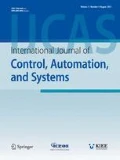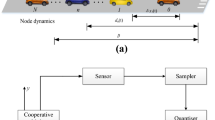Abstract
In this paper, the stability issue of networked system with dynamical topology in intelligent vehicle is studied. The systems are comprised by multi-vehicles coupled by vehicle network. The topological structure of vehicle network is subject to jump, and control signals are exchanged by the communication network with random network-induced delay. Firstly, the discrete-time state space equation for coupled intelligent vehicle with switching topology is modeled. Then, two output feedback controllers are designed by considering the coupling of controllers or not. In which, a new output feedback coupled-controller is designed in order to achieve decouple. Furthermore, the delay-dependent stability conditions on Lyapunov-functional method are given to guarantee the stochastic stability of the closed-loop networked system. Finally, a simulation experiment is executed to illustrate the designed method and verify the stability performance.
Similar content being viewed by others
References
S. Dai, S. He, H. Lin, and C. Wang. “Platoon formation control with prescribed performance guarantees for USVs,” IEEE Transactions on Industrial Electronics, vol. 65, no. 5, pp. 4237–4246, May 2018.
P. Yang, Y. Tang, M. Yan, and X. Zhu. “Consensus based control algorithm for nonlinear vehicle platoons in the presence of time delay,” International Journal of Control, Automation and Systems, vol. 17, no. 3, pp. 752–764, Feb. 2019.
S. Pal and R. Kumar. “Electric vehicle scheduling strategy in residential demand response programs with neighbor connection,” IEEE Transactions on Industrial Informatics, vol. 14, no. 3, pp. 980–988, Mar. 2018.
J. Choi, J. Park, J. Jung, Y. Lee, and H.-T. Choi. “Development of an autonomous surface vehicle and performance evaluation of autonomous navigation technologies,” International Journal of Control, Automation and Systems, vol. 18, no. 3, pp. 535–545, Feb. 2020.
B. Arem, C. Driel, and R. Visser. “The impact of cooperative adaptive cruise control on traffic-flow characteristics,” IEEE Transactions on Intelligent Transportation Systems, vol. 7, no. 4, pp. 429–436, Dec. 2006.
L. Xiao and F. Gao. “Practical string stability of platoon of adaptive cruise control vehicles,” IEEE Transactions on Intelligent Transportation Systems, vol. 12, no. 4, pp. 1184–1194, Dec. 2011.
J. Finke, K. Passino, and A. Sparks. “Stable task load balancing strategies for cooperative control of networked autonomous air vehicles,” IEEE Transactions on Control Systems Technology, vol. 14, no. 5, pp. 789–803, Sep. 2006.
C. Shao, S. Leng, Y. Zhang, A. Vinel, and M. Jonsson. “Performance analysis of connectivity probability and connectivity-aware MAC protocol design for platoon-based VANETs,” IEEE Transactions on Vehicular Technology, vol. 64, no. 12, pp. 5596–5609, Dec. 2015.
B. Liu, D. Jia, K. Lu, D. Ngoduy, J. Wang, and L. Wu. “A joint control-communication design for reliable vehicle platooning in hybrid traffic,” IEEE Transactions on Vehicular Technology, vol. 66, no. 10, pp. 9394–9409, Oct. 2017.
B. Arem, C. Driel, and R. Visser. “The impact of cooperative adaptive cruise control on traffic-flow characteristics,” IEEE Transactions on Intelligent Transportation Systems, vol. 7, no. 4, pp. 429–436, Dec. 2006.
S. Khakpour, R. Pazzi, K. El-Khatib. “Using clustering for target tracking in vehicular ad hoc networks,” Vehicular Communications, vol. 9, pp. 83–96, Mar. 2017.
G. Guo and W. Yue. “Hierarchical platoon control with heterogeneous information feedback,” IET Control Theory and Applications, vol. 5, no. 15, pp. 1766–1781, Mar. 2011.
A. Ferrara and P. Pisu. “Minimum sensor second-order sliding mode longitudinal control of passenger vehicles,” IEEE Transactions on Intelligent Transportation Systems, vol. 5, no. 1, pp. 20–32, Mar. 2004.
J. Chen, H. Zhou, N. Zhang, W. Xu, Q. Yu, L. Gui, and X. Shen. “Service-oriented dynamic connection management for software-defined internet of vehicles,” IEEE Transactions on Intelligent Transportation Systems, vol. 18, no. 10, pp. 2826–2837, Oct. 2017.
Z. Li., H. Yan, H. Zhang, X. Zhan, C. Huang. “Improved inequality-based functions approach for stability analysis of time delay system,” Automatica, vol. 108, pp. 1–8, Oct. 2019.
Z. Li, H. Yan, H. Zhang, Y. Peng, J. Park, Y. He. “Stability analysis of linear systems with time-varying delay via intermediate polynomial-based functions,” Automatica, vol. 113, pp. 1–6, Mar. 2020.
A. Elahi and A. Alfi. “Stochastic H∞ finite-time control of networked cascade control systems under limited channels, network delays and packet dropouts,” ISA Transactions, vol. 97, pp. 352–364, Feb. 2020.
A. Elahi and A. Alfi. “Finite-time stabilisation of discrete networked cascade control systems under transmission delay and packet dropout via static output feedback control,” International Journal of Systems Science, vol. 51, no. 1, pp. 87–101, Dec. 2019.
M. Li and Y. Chen. “Robust adaptive sliding mode control for switched networked control systems with disturbance and faults,” IEEE Transactions on Industrial Informatics, vol. 15, no. 1, pp. 193–204, Jan. 2019.
L. Zhang, M. Chen, T. Li, and H. Wang. “Adaptive event-triggered control for discrete-time networked control systems with actuator faults and nonlinearity,” International Journal of Control, Automation and Systems, vol. 18, pp. 2842–2856, 2020.
H. Zhang, Y. Shi, and M. Liu. “H∞ Step tracking control for networked discrete-time nonlinear systems with integral and predictive actions,” IEEE Transactions on Industrial Informatics, vol. 9, no. 1, pp. 337–345, Feb. 2013.
D. Liao, S. Zhong, J. Luo, X. Zhang, Y. Yu, and Q. Zhong. “Improved delay-dependent stability criteria for networked control system with two additive input delays,” International Journal of Control, Automation and Systems, vol. 17, no. 9, pp. 2174–2182, May 2019.
W. Zou, P. Shi, Z. Xiang, and Y. Shi. “Finite-time consensus of second-order switched nonlinear multi-agent systems,” IEEE Transactions on Neural Networks and Learning Systems, vol. 31, no. 5, pp. 1757–1762, May 2020.
J. Zhai. “Dynamic output-feedback control for nonlinear time-delay systems and applications to chemical reactor systems,” IEEE Transactions on Circuits and Systems II: Express Briefs, vol. 66, no. 11, pp. 1845–1849, Nov. 2019.
Y. Chen, S. Fei, and Y. Li. “Robust stabilization for uncertain saturated time-delay systems: A distributed-delay-dependent polytopic approach,” IEEE Transactions on Automatic Control, vol. 62, no. 7, pp. 3455–3460, Jul. 2017.
Y. Yu, X. Tang, T. Li, and S. Fei. “Mixed-delay-dependent L2-L∞ filtering for neutral stochastic systems with time-varying delays,” International Journal of Control, Automation and Systems, vol. 17, no. 11, pp. 2862–2870, Jul. 2019.
J. Cheng, J. Park, J. Cao, and W. Qi. “A Hidden mode observation approach to finite-time SOFC of Markovian switching systems with quantization,” Nonlinear Dynamics, vol. 100, pp. 509–521, Mar. 2020.
J. Cheng, J. Park, X. Zhao, H. Karimi, J. Cao. “Quantized nonstationary filtering of networked Markov switching RSNSs: A multiple hierarchical structure strategy,” IEEE Transactions on Automatic Control, vol. 65, no. 11, pp. 4816–4823, 2020.
J. Cheng, D. Zhang, W. Qi, J. Cao, K. Shi. “Finite-time stabilization of T-S fuzzy semi-Markov switching systems: A coupling memory sampled-data control approach,” Journal of the Franklin Institute, vol. 357, no. 16, pp. 11265–11280, 2020.
A. Ghasemi, R. Kazemi, and S. Azadi. “Stable decentralized control of a platoon of vehicles with heterogeneous information feedback,” IEEE Transactions on Vehicular Technology, vol. 62, no. 9, pp. 4299–4308, Nov. 2013.
G. Guo and L. Wang. “Control over medium-constrained vehicular networks with fading channels and random access protocol: a networked systems approach,” IEEE Transactions on Vehicular Technology, vol. 64, no. 8, pp. 3347–3358, Aug. 2015.
M. Li and Y. Chen. “Robust tracking control of networked control systems with communication constraints and external disturbance,” IEEE Transactions on Industrial Electronics, vol. 64, no. 5, pp. 4037–4047, May 2017.
L. Ghaoui, F. Oustry, and M. Aitrami. “A cone complementarity linearization algorithm for static output-feedback and related problems,” IEEE Transactions on Automatic Control, vol. 42, no. 8, pp. 1171–1176, Aug. 1997.
G. Guo and W. Yue. “Autonomous platoon control allowing range-limited sensors,” IEEE Transactions on Vehicular Technology, vol. 61, no. 7, pp. 2901–2912, Sep. 2012.
Author information
Authors and Affiliations
Corresponding author
Additional information
Publisher’s Note Springer Nature remains neutral with regard to jurisdictional claims in published maps and institutional affiliations.
This work was supported by the National Natural Science Foundation of China under grant (61903064 and 61973331), the Key Research and Development Program of Sichuan Province under grant (2021YFG0205), the China Postdoctoral Science Foundation funded project under grant (2019M663479), the Fundamental Research Funds for the Central Universities under grant (ZYGX2019J058), the National Key Research and Development Plan Programs of China under grant (2018YFB0106101), and the Postdoctoral Fund Project of University of Electronic Science and Technology of China (UESTC).
Meng Li received his B.S. degree in applied math from Yanan University in 2012, an M.S. degree in applied math from Xihua University in 2015, and a Ph.D. degree in control science and engineering from the School of Automation Engineering, University of Electronic Science and Technology of China (UESTC) in 2018. From 2017 to 2018, he was a Joint PhD student with the School of Electrical and Electronic Engineering, The University of Adelaide. Since Jan. 2019, He was a postdoctor with UESTC. He is currently an associate researcher with the School of Automation Engineering, UESTC. He has published over 20 technical papers in journals and conferences. His current research interests include networked control systems, cyberphysical systems and sliding-mode control.
Yong Chen received his B.S. degree in industrial automation from Taiyuan University of Science and Technology, Taiyuan, Shanxi, in 2001, an M.S. degree in control theory and control engineering from Guangxi University, Nanning, Guangxi, in 2004 and a Ph.D degree in control theory and control engineering from Chongqing University, Chongqing, in 2007. Since 2015, he has been a Professor and the Ph.D. Supervisor in the School of Automation Engineering and the Director of the Institute of Electric Vehicle Driving System and Safety Technology, University of Electronic Science and Technology of China, Chengdu, China. He was a Visiting Scholar in the School of Mechanical Engineering, University of Adelaide. He is currently presiding over one National Natural Science Foundation of China project, National Key Research and Development Plan Programs of China and the Scientific and Technical Supporting Programs of Sichuan Province. He has published more than 80 technical papers in journals and 40 Chinese patents. His current research interests include fault-tolerant control, network control and intelligent connected system.
Rights and permissions
About this article
Cite this article
Li, M., Chen, Y. Robust Control of Networked System and Its Application. Int. J. Control Autom. Syst. 19, 2622–2633 (2021). https://doi.org/10.1007/s12555-020-0471-0
Received:
Revised:
Accepted:
Published:
Issue Date:
DOI: https://doi.org/10.1007/s12555-020-0471-0




